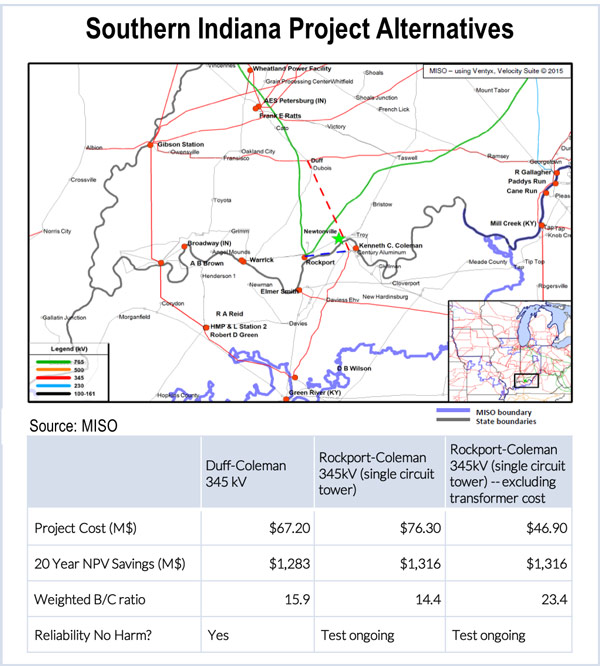Superior Court Directs Suit Against Delmarva to PSC
A class-action challenge to Delmarva Power and Light will be heard by the Public Service Commission after a Superior Court judge ruled that the court doesn’t have jurisdiction. William Whipple III filed the case against the state’s largest utility, arguing that its Bloom Energy Servers program consumes more natural gas than Delaware’s Coastal Zone Act allows. The result, Whipple said, is higher, rather than lower, bills for customers.
But Superior Court President Judge Jan Jurden said the issue comes under the state’s Qualified Fuel Cell Project tariff, which is overseen by the Public Service Commission. The Bloom Energy fuel cell program is partially subsidized by Delmarva customers.
“Plaintiff’s claim for ‘unjust or unreasonable rates’ is a challenge to the QFCP tariff, a regulatory policy which falls within the PSC’s exclusive jurisdiction,” she ruled.
More: Delaware Law Weekly
ILLINOIS
New Calculator Helps Residents Shop for Cheaper Power
Residents have a new free calculator at their disposal to help them save money in the electric market.
The Citizens Utility Board created the CUB Power Deal Calculator to help residents learn what they would pay with an alternative electric supplier compared with their regulated utility, Commonwealth Edison or Ameren.
From 2010 to 2013, when ComEd was locked into higher-priced contracts, it was simpler for consumers to find better deals. Now, however, the last of those contracts has expired.
A June report by the Commerce Commission’s Office of Retail Market Development indicated that ComEd is likely the best deal in the current market. The ICC report found that over the last year, those who got their power from ComEd saved $73 million compared with customers who signed up with an alternative electric supplier.
The calculator can be used for individual plans or deals negotiated by communities.
More: Rock River Times
MASSACHUSETTS
Gov. Baker Poised to Introduce Solar Bill

Gov. Charlie Baker said last week that his administration is ready to introduce legislation that is expected to address caps on solar power net metering, a hot issue in the state these days. Baker and state officials offered few details of the proposed legislation, saying only that it would build “upon the success and continued growth of Massachusetts’ solar industry while ensuring a long-term, sustainable solar program that facilitates industry growth, minimizes ratepayer impact and achieves our goal of 1,600 MW by 2020.”
The promise of further legislation comes after the Senate approved a bill that raises the solar power net metering cap to 1,600 MW. But the bill was criticized by an industrial users group. Associated Industries of Massachusetts said it would provide a subsidy that “could add as much as $600 million to the electric bills of Massachusetts consumers, businesses and institutions.” The group said the bill benefits only those who are able to install solar facilities, at the expense of those who can’t.
More: MassLive
MINNESOTA
PUC Approves $125 Million Upgrade to Crude Pipeline

Minnesota Pipe Line is co-owned by Flint Hills Resources, owner of Rosemount’s Pine Bend refinery; Northern Tier Energy, which owns the St. Paul Park refinery; and a third investor. The pipeline is operated by Koch Pipeline — like Flint Hills Resources, a unit of Koch Industries.
More: Star Tribune
NEW JERSEY
Small Hole Found, Filled in Protective Wall at Hope Creek

The 1-inch hole was noticed by workers about 2 p.m. Tuesday and was sealed within two hours. The opening was found inside a closed auxiliary building and did not open into the environment, the utility said. It said that the primary containment containing the reactor core and major safety systems were unaffected, and that operations were uninterrupted.
PSEG Nuclear spokesman Joe Delmar said the hole apparently dated to the original construction when concrete was formed and poured. “There are more than 100 of these holes. All of the other holes were filled with grout/filler material,” he said. “There is no evidence that there was grout/filler in this hole. We continue to investigate and determine if it may have been filled at one time and not refilled.”
More: The News Journal
NORTH CAROLINA
Report: Geothermal Industry Growing in State

The report also said that because of uncertainty surrounding the survival of the tax credit, geothermal installation growth stagnated in 2014. According to a survey conducted by the NCSEA, the tax credit was the single most important consideration among those who decided to install geothermal systems, with 92% of respondents saying it was a determining factor.
“Energy efficiency is the low cost, least risk resource and [geothermal heat pumps] are the most energy-efficient technology for satisfying the thermal loads of homes and buildings,” said Robert Rust, territory manager for WaterFurnace International.
More: North Carolina Sustainable Energy Association
NORTH DAKOTA
172-MW Wind Project Considered Again by PSC
A wind farm originally proposed by a California company whose ownership was transferred to a North Dakota firm is again up for consideration before the Public Service Commission. The Antelope Hills Wind Project, a $240 million, 172-MW wind facility, originally received a permit in December. Ownership transferred to SUNE North Dakota Holdings in April, and the company has to reapply for approval. A hearing is set for September to consider the project.
The wind farm would be constructed on 22,000 acres near Beulah. While the project still calls for 85 turbines, the location of some of the turbines has changed.
More: Bismarck Tribune
OHIO
Utilities Push Back on Net Metering
FirstEnergy and American Electric Power are challenging how much they must pay solar owners for excess power and how much of it they are required to buy back, now that there are nearly 1,600 solar arrays operating in the state.
The Public Utilities Commission is considering revising its January 2014 ruling limiting net metering to 120% of a user’s average monthly demand over the previous three years.
The two utilities also have taken their challenge to the state Supreme Court, but the court is waiting to rule until the commission reconsiders its position.
More: The Plain Dealer
FirstEnergy CEO Wants State Power Industry Re-regulated

“I think it makes sense. I am trying to save a company,” he said.
In 2008, FirstEnergy was poised to prosper from coal-fired plants that provided some of the cheapest power in the state. Now, Jones said, FirstEnergy may not survive if it can’t convince the Public Utilities Commission to force ratepayers to cover the full cost of electricity from two of its huge coal and nuclear plants.
More: The Plain Dealer
PENNSYVLANIA
Talen Reaches Proposed Settlement on Coal Ash Spill

The settlement, which still needs to be approved by DEP after public comment, would result in Talen paying $1.3 million to settle all natural resource damage claims from the spill. PPL, then the owner of the plant, spent $37 million on the cleanup, including a $1.5 million civil settlement.
The coal units at the plant were retired in 2007. Talen Energy now operates three oil and natural gas units generating 1,700 MW at the site.
More: Lehigh Valley Live; Pennsylvania Department of Environmental Protection
RHODE ISLAND
First Offshore Wind Foundation Laid

“A place like Block Island, which could only burn dirty diesel fuel, now will have the opportunity for clean, renewable energy,” Jewell said as she stood at the bow of a ferry as it rocked in the swells off the tiny island. She was accompanied to the site of the five-turbine wind farm, about three miles southeast of Block Island, by Gov. Gina Raimondo, the state’s congressional delegation, and other public officials.
More: Providence Journal
VERMONT
Family Seeking Approval for Large-Scale Wind Project
A local family is gathering data with an eye toward developing a seven-turbine wind project on a ridge in Swanton.
The Belisle family is working with Vermont Environmental Research Associates to put together the plan before applying to the state for permission to build. The family has said it would like to begin construction by the end of 2016. When completed, according to Martha Staskus of Vermont Environmental Research, the 20-MW Swanton Wind farm would produce enough energy to power about 7,800 households.
In addition to gathering technical information for a feasibility study, the Belisle family is reaching out to neighbors and other community members to hear their concerns.
The project, however, is already facing some opposition. “The state has done absolutely nothing to recognize that this type of development causes tremendous harm to the environment and to the health and welfare of people living around the mountains,” said Annette Smith of the Danby-based group Vermonters for a Clean Environment. As a result of some complaints, a test tower is already being taken down.
More: Rutland Herald; Associated Press
Siting Task Force Studies Solar Growth
A panel created by the Legislature to study the growth of solar power in the state will meet for the first time this week. The Solar Siting Task Force was charged with reviewing the design, location and regulation of solar electric generation facilities, and is due to report back to lawmakers in January with recommendations.
A new renewable energy law established the 10-member panel and set a requirement that 55% of the power sold by energy companies come from renewable sources by 2017 and 75% by 2032. The state has a broader goal of getting 90% of its energy from renewable sources by 2050.
The task force is made up of state and utility officials, a landscape professional and a member of the general public. It is responsible for addressing concerns raised by some municipalities and others about the fast growth of solar power projects in the state.
More: Burlington Free Press
Study Quantifies Solar Energy’s Benefits

“Solar generation is a valuable local energy resource that provides significant benefits to ratepayers,” said Ellen Hawes, Acadia’s senior analyst for energy systems and carbon markets. The study said solar provides value to the electric grid by reducing energy demand, providing power during peak periods and avoiding generation and related emissions costs incurred by conventional power plants. The study suggests the overall grid value of solar is the sum total of those various benefits.
In addition to the value that solar provides to the grid, Acadia’s study found that it provides broader societal benefits, including environmental gains from reducing greenhouse gas emissions and other pollutants.












